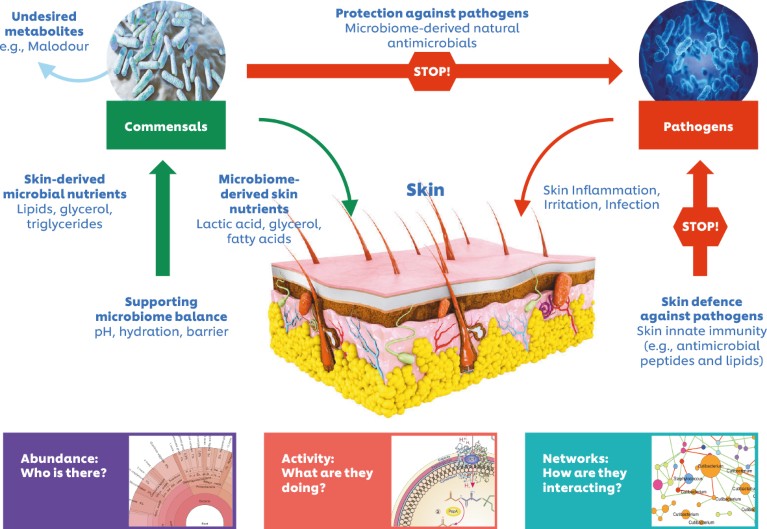The human body and its associated microorganisms form a joint ecosystem —the ‘holobiont’. At a cellular level, we are made of microbes as much as human cells, with physiological implications for development, health, beauty and even mood.
An imbalance in the microecology of skin, scalp and oral surfaces can cause conditions such as eczema, atopic dermatitis, acne, dandruff and gingivitis. In addition, the invasion or transient colonization of the skin by pathogenic microbes, including viruses, has been linked to the transmission of communicable diseases. Benefits have traditionally been delivered through topical antimicrobials, which are typically broad spectrum and rely on the indiscriminate removal of skin-surface microbes. Although effective antimicrobial action is irreplaceable in certain situations, there is increasing recognition of the benefits afforded by ‘good’ microbes and healthy microbial diversity. Developing responsible microbiome health and hygiene technologies that work in harmony with the human body is essential to maintain overall ecosystem well- being (see Figure).

The skin–microbiome partnership. The interplay between the skin and skin microbiome. Adapted from ref. 4 with the permission of the authors, under the terms of a Creative Commons Attribution 4.0 International License.
Over the past 20 years, Unilever has invested in fundamental and translational research to understand the skin, scalp and oral microbiome. Unilever’s philosophy is to build and translate understanding of a balanced microbiome into new innovations, respecting the holistic host– microbe ecosystem in a sustainable and care-orientated manner.
Our strategy explores links between skin conditions and the microbiome and the role of innate immunity, combining multi-omics, data analytics and machine- learning tools with in-vitro, host– microbiome co-culture models and clinical studies. Unilever’s approach helps probe subtle changes in the microbiome, identifying novel associations and target microbes1, whilst elucidating cross-talk with skin cells.
Unilever is exploring multi-pronged technology approaches that selectively weaken or kill ‘bad’ microorganisms while harnessing the power of ‘good’ bacteria. These include phage technologies or bacterial metabolic interventions preserving well-being-associated microorganisms using mild/pH- balanced formulation strategies; boosting good effects through pre/pro/postbiotic technologies; and promoting the skin’s innate immunity mechanisms (such as antimicrobial peptides/lipids)2.
Since its initial investigation into the axillary microbiome in the early 2000s, Unilever has completed over 60 microbiome studies including large population and longitudinal cohort studies across Europe, Asia and America. Academic and government partnerships have enabled us to comprehensively map the human microbiome in the context of demographics and body niches. Studies on hygiene, cosmetic conditions, lifestyle and product use have resulted in over 100 peer-reviewed publications and presentations, as summarized in recent extensive reviews on the microbiomes of healthy body skin and human axillary malodour3. The international microbiome research team at Unilever works co-operatively with a network of external partners to advance research and build the next generation of scientists, supporting multiple PhD studentships since 2016.
Unilever has invested in strategic partnerships globally with academics on a diverse range of areas. These include the Liverpool School of Tropical Medicine, Kings College London, and the universities of Liverpool, York and Oxford in the UK, the Chinese Academy of Sciences, Indian Institute of Science and National Centre for Biological Sciences in Asia, and the University of Pennsylvania, University of California San Diego and Massachusetts Institute of Technology in the United States. Additionally collaborations have been made with Eagle Genomics and the Hartree-IBM centre for developing sector-leading data management and analysis.
These strategic investments in microbiome capability and translational research have led to over 25 microbiome-related product launches, including major brands such as Dove, Vaseline, Lifebuoy, Zendium and Ponds, supported by more than 90 patents.
We believe this is only the beginning of the journey — growing understanding of human microecology and human– microbiome interactions will unlock new opportunities for innovating sustainable product technologies.

